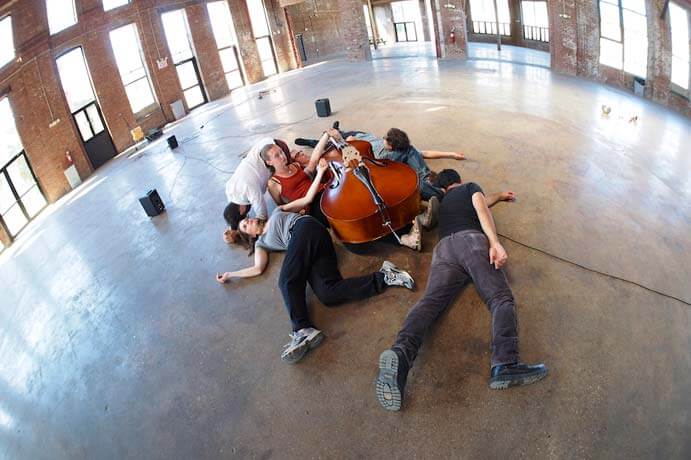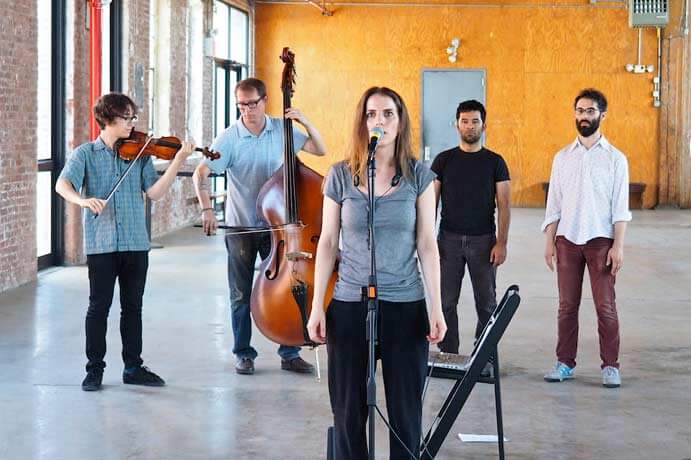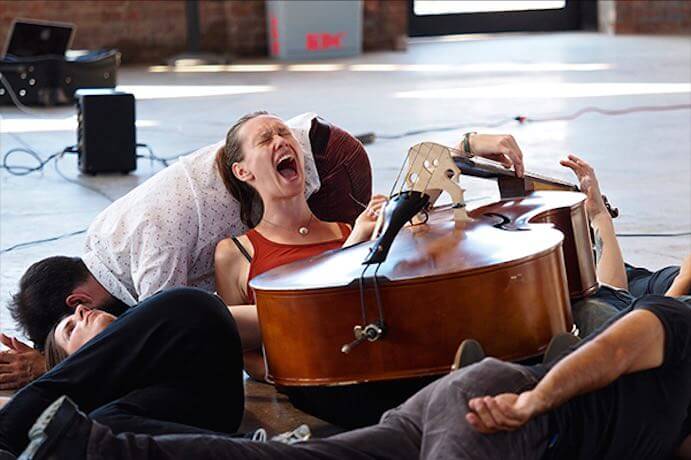Remember the noise of Hurricane Sandy, and you’ll probably remember not just the storm itself—with its wind, rain, and eerie silences—but those other sonic indicators of disaster: perpetual television chatter, service phone calls, the wearying, endless patter of leaks. thingNY’s latest production This Takes Place Close By has resurrected that sound world with a stunningly effective mélange of singing, acting, electronics, and extended vocal techniques, bringing its audience poignantly back to the exigencies and devastation of the flood.
The group chose a relatively far-flung performance venue, The Knockdown Center in Maspeth, a sprawling 50,000-square-foot converted factory tucked away on a gated lot, a 20-minute walk from the closest subway. But viewers were given substantial payback for the trek. thingNY made use of every part of the physically impressive, cavernous space, prompting the audience to travel the length of the building as performers migrated to new areas scene by scene.
This Takes Place Close By opened with the six composer/performers of the collective forming a large circle around the audience, which itself loosely circled around a raised platform surrounded by splintered logs. The opening song provided a staggering litany of flood and hurricane-related fatalities throughout history: a flood in 1219 in Frisia that killed 36,000, a 1975 typhoon and dam failure in Henan Province that killed 80,000, and on and on, as the singers questioned “Where? When? Are they ok?” A brittle, insistent piano pedal point persisted through zones of intensity in the opening music, which echoed a storm with cascades of rumbling noise and sudden walls of dissonance. The scene then shifted from generalized to personalized death, as the performers walked through the crowd to form a heap of bodies amidst the rubble surrounding the stage. As they sang the ghostly “Death Comes Quick,” the audience was transformed into a crowd of spectators, voyeuristically hovering over the latest disaster.

thingNY in rehearsal at the Knockdown Center (photo: Michael Yu)
By initially enclosing its audience, thingNY established porous viewer/performer dynamics that persisted throughout the opera. As the performers guided the audience all over the space, often walking through and among the crowd, the group continually resituated itself in relation to its audience, creating a physical sense of immersion that complimented the widespread circulation of lighting and sound design throughout the space.
All of the opera’s vignettes provided convincing glimpses into the disorientation and hardship caused by the storm, but the highlight of these scenes was a jaw-dropping experimental aria performed by vocalist/saxophonist Erin Rogers. Rogers portrayed both an automated 911 operator, with an infuriatingly implacable tone, and the frantic callers, whose 911 calls were conveyed entirely with inarticulate wails, huffs, and bursts of frenetic sound. The operator’s lines were spot-on, always incommensurate with the calamity at hand: “What is your emergency? You can say: Elderly spouse, hurricane, shady characters on your block, loss of power, loss of vision…I’m sorry, I didn’t understand…Let’s try again.” Rogers would then shift instantaneously into an answering hyperventilation, thrusting the audience uncomfortably into that wide impasse between Disaster and System.

thingNY members (l-r) Jeffrey Young, Andrew Livingston, Erin Rogers, Paul Pinto, and Dave Ruder (photo by Michael YU)
Many scenes in This Takes Place Close By consistently and cleverly return to the failure of speech, using the extended dramatic possibilities of experimental vocalization and inventive electronics to take over where words falter—to situate us emotionally in rootlessness and trauma, in patterns of chaos that are natural yet increasingly man-made. Scene by scene, I was consistently caught up in a conviction that I have rarely, if ever, seen an encyclopedic array of experimental effects so intimately linked with their expressive potential.
The opera closes with composer/percussionist Paul Pinto sitting in a room festooned with flood-soaked papers, buried behind a desk piled high with letters from survivors of various disasters throughout history. He sings excerpts of these letters against rousing bariolage, at one point intoning a letter from himself: “Yeah, there’s beauty in the rubble. But not enough to make art from…probably just enough to make porn from.” I suppose I’ll beg to differ.




















